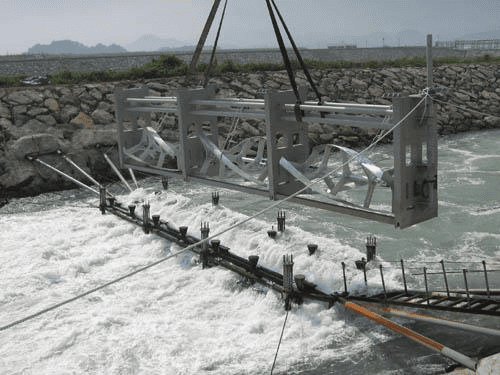In this post is explained the operation and applications of Gorlov turbine. It is a modification of Darrieus turbine and used in wind and hydroelectric energies.
The following button access the post about Darrieus turbine.
How it works?
The blades of Darrieus turbine don’t generate torque in full turn, because in some positions the wind direction is parallel to blade’s speed vector. So, Darrieus turbine does not produce constant torque.

This is the graphic of torque in function of rotation angle of a 17 meters Darrieus turbine in three speeds.

A solution is to “twist” blades in helical shape. As a result, part of blade will always be positioned in an angle which has resultant torque, don’t matter wind’s direction. In this example, wind direction is on the left.

Induced flux by blades is in counterclockwise direction, because Gorlov turbine spins in clockwise direction.

The induced flux and wind create a resulting flux showed in figure below.

Producing a resultant force which generates torque.

Gorlov turbine in hydroelectricity
This type of turbine was designed initially to applications in hydroelectricity. Can be used to generate energy in rivers without the need of a dam. Therefore, cost and environmental impact are lower.

Also can be used in tides and ocean currents.

Gorlov turbine can also be vertically positioned.

Fishes can pass through turbine with low risk of get hurt or stuck. Because it has free space enough and the speed isn’t too high.
Application in wind energy

These wind turbines are made of composites materials which need to be light, durable and rigid, like carbon fiber. Gorlov wind turbine is more efficient than Darrieus and Giromill turbines. Can be installed in roofs and top of buildings.

Other features
- Can generate a smoother torque, so has less vibration and noise than Darrieus.
- Gorlov turbine always spins in the same direction, independent of flux direction.
- Stress in blades is reduced.
- Has about 35% of efficiency.
- Due to helical shape, does not need motor to start.



